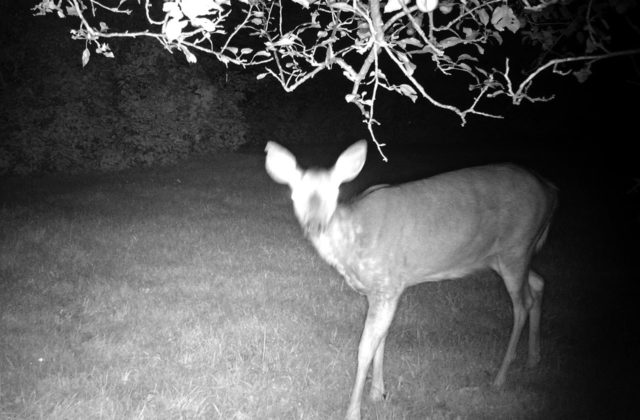Nocturnal Animals Enliven the Norfolk Darkness
By Jude Mead
Photo by Fred Knight
Norfolk is considered a quiet town during the cold winter months, leading to the mistaken impression that the village rolls up its streets at dusk and slumbers until dawn. Actually that is the time when the exciting world of darkness comes alive and the stillness of the night is charged with nature’s nocturnal creatures. Norfolk has a wild night life.
Some animals settle down as the sun begins to set. Others come alive. They are called nocturnal because they sleep through the day and become active at night. These animals compensate for the lack of light with their sharp senses of hearing, sight and smell. The twilight and night hours allow them to forage or hunt with less competition and to avoid predators.
Erinn Whitmore, a naturalist from the Sharon Audubon Center, has encountered many animals and birds on her winter nighttime ventures. Among them are porcupines, raccoons, deer, coyotes, rabbits, owls, turkeys, opossums and flying squirrels. She even saw a bobcat once, although she really had to keep her eyes peeled to see it.
According to Whitmore, exploring the dark is a chance to meet many nocturnal creatures. “It’s thrilling. Each time I see something different. There is so much activity outside after dark, and you don’t have to go deep into the woods to find it.”
Attitude can help or hinder the chances of seeing any creatures. Animals sense fear. She suggests being calm and moving slowly, but only when necessary. Being respectful toward animal’s habits is also essential. “It is important to keep your distance when observing animals and trust that they just want to go about their business,” she said.
People also depend on their senses of sight, hearing and smell, just as most animals do. “To become better aware of your surroundings you have to train your senses for the dark. For our eyes to adjust to the dark and our pupils to dilate completely takes at least a half hour. Also be alert to the sounds and smells around you,” said Whitmore.
Becoming a backyard naturalist means having the right equipment. Whitmore recommends carrying a flashlight for safety but turning it on only when necessary so as not to scare the night life. She added that a trail camera is handy and dressing in camouflaged clothing helps. Perhaps the most essential element for Whitmore is patience.
“Sometimes you have to stay in one spot for a long time in order to see the wildlife. Keep very still. Any motion can alarm animals. They will warn of danger by thumping the ground, making noise or emitting a strong scent,” she said.
Studying nocturnal creatures in their normal surroundings can reveal much about their behavior. Foragers such as skunks, porcupines, raccoons and opossums are all digging animals with long claws. They like to be near streams and forage under rocks for food. “Most will eat grubs, worms, berries or insects. The porcupine has a specific digestive system and can be spotted eating the inside of tree bark or berries,” she said.
Whitmore has noticed other characteristics as well. If an opossum hears you approach, it will play dead. An attacker can probe, bite or yell, and it will not move until the danger is gone. Porcupines on the other hand will run away. Quills are used only as a last defense. They do not shoot their quills; the quills stick to whatever touches them.
Deer feeding on grass in fields are probably the most common nighttime animal sighting for people, but animals that hunt, such as the fox, the coyote and the bobcat, also move at night. “They are very elusive, and seeing one is thrilling. They are territorial and search for a wide variety of food from berries to rabbits. Coyotes will even take down a deer or domestic pet. They are sometimes vocal, and their cries signal either a food source or danger,” said Whitmore.
A bobcat sighting is very rare. Most hunt near rocky ledges where they den and are shy of humans. They move in the thick of night to find their prey. Whitmore mentioned that they have a keen nose and can even smell food hidden under a heavy blanket of snow.
Some birds also favor the night life. Owls are the most common and often frequent woodlots, where they can be spotted sitting on branches before taking a swoop down on an unsuspecting mouse or rabbit. All owls hunt using both their eyes and ears.
“Owls are capable of seeing the ultraviolet light reflected in urine, making it easier for them to track their prey. They have evolved the largest eyes that can possibly fit their skull. It would be like a human having eyes as big as grapefruits,” said Whitmore. An owl’s ears are also well developed. Sometimes that is all it needs for hunting.
While having a dark night sky is an advantage for many animals, it is an opportunity for people to turn off television, put down a book and step outside. Give it a try. It might turn an ordinary evening into an adventure. You never know what animal you will encounter. As Whitmore concluded, “We don’t get much chance to cross paths with many animals. Catching even a glimpse of one is something special.”

